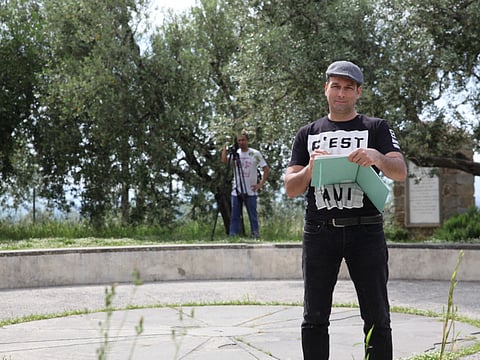UAE artist makes film to honour Leonardo Da Vinci
Sylvain Tremblay documentary follows the painter and art history professor as he discovers the works of the Italian Renaissance artist

To make his students more interested in art history, professor Sylvain Tremblay came up with a novel idea: to make a documentary film about Leonardo Da Vinci.
Tremblay, an accomplished painter, spent two years researching his subject and travelling across Europe to film it. His labour of love The Master Project: Leonardo Da Vinci — which follows Tremblay as he visits places in Italy and France where Da Vinci’s works are preserved — was screened last month at the Chateau du Clos Luce in France where Da Vinci spent the last three years of his life.
Tremblay, 51, worked with the Canadian University of Dubai, where he once taught, for the film.
“We are always keen to find new ways to bring his teachings and learnings to our students. This documentary is one of the ways we are doing this,” said vice-chancellor Karim Chelli.
Tremblay, a former UAE resident who currently works between Montreal and New York, and Stephane Chabas, the film’s director and producer, recently spoke to Gulf News tabloid! about the project.
What influenced you to create the film?
Tremblay: There’s a subject titled Art History and one of the topics covered are Renaissance Italy. In this topic, we talk about Da Vinci. I wanted to find an interesting story and I decided to start with Da Vinci to explain to my students.
What were the costs of doing the film?
Tremblay: The costs are difficult to be precise. We had to buy 4K cameras and new computers. We spent about $50,000 [Dh183,610] on making the documentary but that’s not it. If we consider the value of time and efforts, it would cost around $100,000.
What filmmaking techniques did you use to make the documentary?
Chabas: We tried to be innovative in the way we approached the creation of this documentary by using modern filming techniques such as hyper lapses, time lapses, we also tried to produce the most visual film we could. The goal was to tell this story with images more than with words.
What were the challenges of directing and producing the documentary?
Chabas: We have filmed this documentary with a very [small] team, Sylvain and I, and therefore we had to manage on our own all the technical aspects of the audiovisual production from script to filming , to staging, to post production. It’s required to be very versatile and passionate in the field of creation. Thankfully we are a very complementary team with Sylvain.
Tell us about the venue of your premier, Chateau of Clos Luce.
Tremblay: Da Vinci lived at the Chateau during his last three years as he was invited to work with the King of France [Francis I]. Even after his death, the King called Da Vinci as his ‘father’.
How has Da Vinci influenced your life?
Tremblay: Da Vinci is not just a painter. He’s an engineer, architect and mathematician. He used science to understand art and used art to understand science. He made me pay more attention about everything around me.
Are your UAE-based artworks influenced by Da Vinci?
Tremblay: When I was in Dubai, I included sand in my painting and used elements that are around me. He made me a better observer than before.
What do you aim for your students to learn from Da Vinci and your documentary?
Tremblay: After teaching them about Da Vinci in the Art History subject, they study and then have to give a lecture in class. Some of them were so good that they did lectures in front of a lot of other students because they learnt a lot about Da Vinci.
What can people who aren’t necessarily into art learn from Da Vinci and your documentary?
Tremblay: When you study about Da Vinci, you discover not only painting, you discover secrets, tips and really enjoy [studying] Da Vinci. Every painting that he did takes time and the methods used were professional that we still use today.
How can professionals and amateurs learn from Da Vinci’s artworks?
Tremblay: First observe, second, you plan the sketches and then do the artwork. Preparation is very important. You don’t go direct to do the artwork. Before you start the painting, you have to work really hard. To know art, you have to understand the portrait and you need to sketch a lot to do the real painting.
Do you plan to submit your documentary across film/documentary festivals?
Chabas: The film will be submitted in different festivals across the world, we are also planning a premiere at the Canadian University Dubai in October.
Will the film have a wide release?
Tremblay: It’s too soon to put a date on it.
To find out more about the film and Sylvain Tremblay’s works, go to sylvaintremblay.ca.
— Viraj Asher is an intern at Gulf News.
Sign up for the Daily Briefing
Get the latest news and updates straight to your inbox



